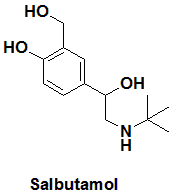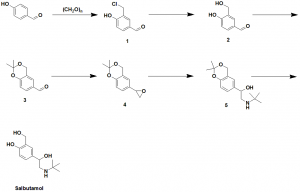SALBUTAMOL Synthesis, SAR, MCQ,Structure,Chemical Properties and Therapeutic Uses
Salbutamol
IUPAC nomenclature
(RS)-4-[2-(tert-Butylamino)-1-hydroxyethyl]-2-(hydroxymethyl)phenol.

Classification
Salbutamol is ß2-adrenergic agonist. [1]
Physiochemical Properties
| S. NO. | PHYSICAL AND CHEMICAL PROPERTIES | |
| 1 | Molecular weight | 239.31 g/mol |
| 2 | Physical appearance | Off-white to white crystalline solid |
| 3 | Melting point | 151°C |
| 4 | Solubility | 0.06M in water |
| 5 | Octanol/water partition coefficient | 1.4 |
| 6 | Presence of ring | Benzene ring present |
| 7 | Number of chiral centers | 1 |
Mechanism of Action
i. Adenyl cyclase enzyme is stimulated through the ß-adrenergic receptors.
ii. The conversion of ATP to cyclic AMP also increases due to this.
iii. Due to raise in level of CAMP, relaxation of bronchial smooth muscles and inhibition of release mediators of immediate hypersensitivity from mast cells takes place.
Structure Activity Relationship
- Primary or secondary aliphatic amine separated by two carbons from a substituted benzene ring is essential for the high agonist activity.
- The hydroxyl substituted carbon must be in the R configuration for the maximal direct activity.
R1 substitution:
- When R1 is increased in size, activity of alpha receptors decreases and activity of the beta receptors increases
- Activity of both alpha and beta receptors is maximum when R1 is methyl group.
- Alpha agonist activity decreases when R1 is larger than methyl, and went negligible when R1 is isopropyl.
- Large lipophillic groups can afford compounds with alpha blocking activity.
- N-substituent provides selectivity for different receptors.
- Arylalkyl group can provide beta selectivity, increased cell penetration and increased lipophillicity for the longer duration of action.
R2 substitution:
- Ethyl group can eliminate the alpha activity of the drug.
- Erythrostero isomers have maximal activity.
- The additional methyl group makes the drug more selective for the alpha2
R3 substitution on the aromatic ring:
- 3’,4’-dihydroxy substituted benzene ring has poor oral activity.
- 3’, 5’-dihydroxy compounds are orally active.
- At least one of the groups is required which can form hydrogen bonds. And if only one group is present then it is preferred at 4’ position to retain the beta2
- If phenyl group has no phenolic substituent then it may act directly or indirectly.[2]
Method of synthesis
i. p-hydroxybenzaldehyde and paraformaldehyde reactes to form compound (1)
ii. Compound (1) in reacts with unboiled water to ive compound (2) at weak basic conditions.
iii. Two hydroxyl under sulfuric acid catalyst is protect by propylidene.
iv. Compound (4) is obtained under ylide reagent and phase transfer catalyst effect, utilizing highly asic effect.
v. Compound (4) undergoes reflux in tert-butyl amine to carry out aminolysis ring opening reaction and to get compound (5).
vi. Hydrolysis of compound (5) in acidic conditions gives Salbutamol.

Therapeutic Uses
The drug is used:
- Bronchospasm
- Chronic obstructive pulmonary disease
- Acute hyperkalemia
Salbutamol is also used:
- In obstetrics
- As a tocolytic
Side Effects
Common side effects of salbutamol are palpitations, headache, dry mouth, anxiety, tremors and muscle cramps.
Less common side effect of this drug are sleep disturbances, myocardial ischemia, skin problems, arrhythmias and tachycardia.
MCQs
Q.1 What can be the correct IUPAC nomenclature of salbutamol?
a) 2-(naphthalen-1-ylmethyl)-4,5-dihydro-1H-imidazole
b) 2-[(4-tert-butyl-2,6-dimethylphenyl)methyl]- 4,5-dihydro-1H-imidazole
c) (RS)-4-[2-(tert-Butylamino)-1-hydroxyethyl]-2-(hydroxymethyl)phenol
d) (RS)-[4-(1-Hydroxy-2-tert-butylamino-ethyl)-2-(4-methylbenzoyl)oxy-phenyl] 4-methylbenzoate
Q.2 Which amongst the following statements is/are incorrect related to the SAR of Salbutamol?
I. At least one of the groups is required at R2 which can form hydrogen bonds. And if only one group is present then it is preferred at 4’ position to retain the beta2 activity
II. 3’,4’-dihydroxy substitution at benzene ring has higher oral activity
III. Large lipophillic groups at R1 can afford compounds with alpha blocking activity
a) II
b) I, II
c) I, III
d) II, III
Q.3 Type of ring present in the structure of salbutamol?
a) Pyrimidine
b) Purine
c) Benzene
d) Aliphatic ring
Q.4 Side effects of drug Salbutamol is/are?
a) Palpitations
b) Headache
c) Anxiety
d) All of the above
Q.5 Match the following drugs with their correct molecular weights-
| i. Salbutamol | A. 239.31 g/mol |
| ii. Bitolterol | B. 210.27 g/mol |
| iii. Naphazoline | C. 461.5 g/mol |
| iv. Xylometazole | D. 244.37 g/mol |
a) i-B, ii-A, iii-D, iv-C
b) i-B, ii-A, iii-C, iv-D
c) i-D, ii-C, iii-A, iv-B
d) i-A, ii-C, iii-B, iv-D
Q.6 An example of drug from class ß2-adrenergic agonist?
a) Salbutamol
b) Clonidine
c) Prazosin
d) Norepinephrine
Q.7 Salbutamol is used for the treatment of?
a) Acute Hyperkalemia
b) Bronchospasm
c) COPD
d) All of the above
ANSWERS
1-c
2-a
3-c
4-d
5-d
6-a
7-d
REFERENCES
[1] Lemke TL, Zito SW, Roche VF, Williams DA. Essentials of Foye’s principles of medicinal chemistry. Wolters Kluwer; 2017, 340 [2] Lemke TL, Zito SW, Roche VF, Williams DA. Essentials of Foye’s principles of medicinal chemistry. Wolters Kluwer; 2017, 348-352